What is Arch?
An arch is a curved architectural shape that takes loads around an entrance and transfers them to abutments, jambs, or piers on either side of the arch’s profile. Since the Etruscans, arches have been a popular architectural feature, credited with inventing them, though the Romans refined and popularized them. Many other structural forms, such as vaults, arcades, and bridges, have evolved from the techniques used to design and construct arches.
There are no tensile stresses in arches because they are compressive constructions. They are self-supporting and are held in compression by the force of gravity acting on their weight. It makes them extremely stable and efficient, allowing them to span greater distances and carry heavier weights than horizontal beams.
Construction of Arches:
An arch is a wedge-shaped unit that is used to construct a structure. Intrados refers to the arch’s inner curve, whereas extrados refers to the arch’s outer curve. The purpose of the arches is to support the weight of the wall area above the openings. In this post, you’ll learn about the several types of arches commonly employed in the construction of various constructions.
Where the span between the two supports is greater, and the load on the supports is greater, arch construction is necessary. Arches are frequently employed as an architectural element to enhance the structure’s aesthetic appeal.
Different Types of Arches in Construction:
1. Types of Arches According to Shape:
i) Pointed Shape Arch:
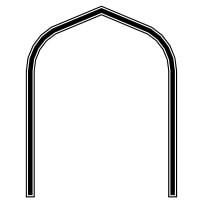
Fig 1: Pointed Shape Arch
Courtesy: civiconcept.com
In this type of arch, two arcs of circles meet at the apex; hence triangle is formed. It may be either isosceles or equilateral. The other name of the pointed Shape arch is the Gothic arch.
ii) Flat Arch:
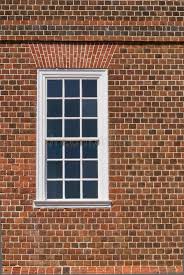
Fig 2: Flat Arch
Courtesy: dreamstime.com
With intrados as the basis, the Flat arch produces an equilateral triangle at a 60-degree angle—flat arches commonly employed in the construction of lightweight structures. Even though the intrados is flat, minor settlements are enabled by allowing a slight rise in camber of roughly 10 to 15 mm per meter width of the opening.
Extrados is likewise flat and horizontal. Flat arches are commonly utilized for light loads and span up to 1.5 meters.
iii) Horseshoe Shape Arch:
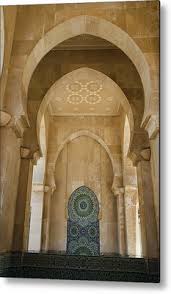
Fig 3: Horse Shape Arch
Courtesy: fineartamerica.com
Although it curves more than a semi-circle, the horseshoe arch shaped like a horseshoe is considered an architectural provision.
iv) Segmental Arch:
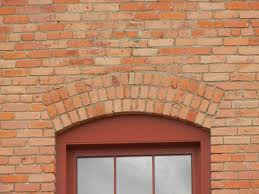
Fig 4: Segmental Arch
Courtesy: imiweb.org
This arch is less than a half-circle in length. All of the arch’s voussoirs radiate outwards from the curve’s core. Skew-backs are required at the tops of the abutments and piers for this arch. This arch sends a horizontal thrust to the piers that support it along with the vertical force.
v) Venetian Arch:

Fig 5: Venetian Arch
Courtesy: hisour.com
The crown of the Venetian arch is deeper than the crown of the springing arch. It has four Centers, all placed on the springing line.
vi) Semi Circular Arch:
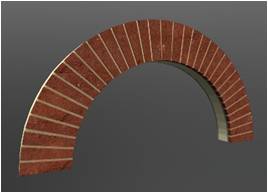
Fig 6: Semi Circular Arch
Courtesy: civiconcept.com
The center of the semi-circular arch will be on the spring line. The thrust transferred to the abutment in the semi-circular arch is vertical.
vii) Semi-Elliptical Arch:
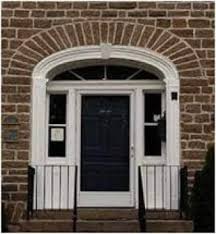
Fig 7: Semi Elliptical Arch
Courtesy: civiconcept.com
The shape of a semi-elliptical arch is like a semi-ellipse with three or five centers. The basket-handle arch is another name for the semi-elliptical arch.
viii) Stilted Arch:
A semi-circular arch with two vertical parts at the springing is known as a stilted arch. The horizontal line that runs across the summits of the vertical parts is the arch’s center.
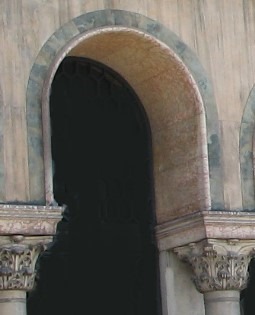
Fig 7.1: Stilted Arch
Courtesy: theconstructor org
ix) Relieving Arch:
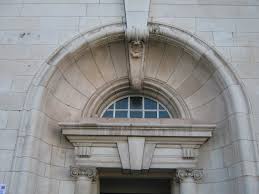
Fig 8: Relieving Arch
Courtesy: flickr.com
A relieving arch is built over a flat arch or on a wooden lintel to give more strength. In the case of a relieving arch, we may easily replace the deteriorated wooden lintel without affecting the structure’s integrity. This arch’s ends carried far enough into the abutments.
2. Types of Arches According to Material:
i) Stone Arches:
The stone arches are divided into two types:
a) Ashlar Arches:
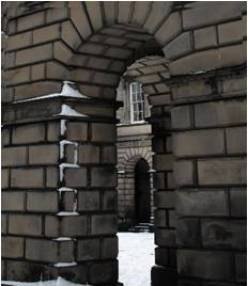
Fig 9: Ashlar Arches
Courtesy: ribapix.com
The stones are properly prepared and linked with cement mortar in this style, and they cut to the right shape of voussoirs (a wedge-shaped or tapering stone used to construct an arch). Flat arches are also made using ashlar stones.
b) Rubble Arches:
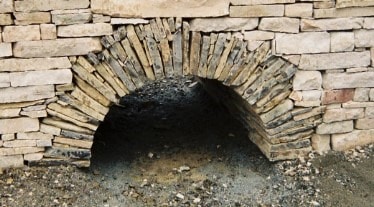
Fig 10: Rubble Arches
Courtesy: civiconcept.com
Rubble arches are used to construct arches with up to a one-meter span. Rubber stones that have been hammered and treated make these types of spans. The rubble arches are unstable and are reserved for low-quality work. The mortar is used to hold stones together.
ii) Brick Arches:
Brick arches are one of the most commonly utilized arches in construction. It is a sort of art that is made out of ordinary bricks. The brick arches are constructed using cement mortar.
There are three different types of brick arches:
a) Rough Brick Arches:
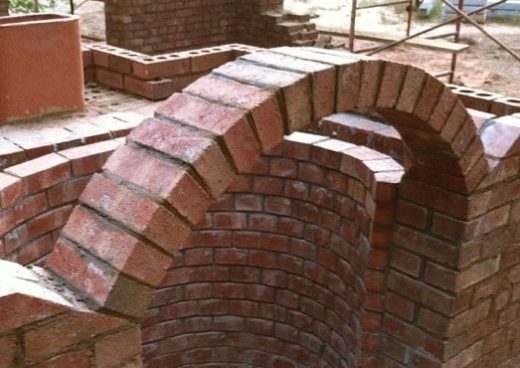
Fig 11: Rough Brick Arches
Courtesy: theconstructor.org
Rough brick arches are created by constructing arches without trimming ordinary bricks into the shape of stones. Because the arched joints are wedge-shaped, the arch curve is thicker at the extrados and thinner at the intrados.
b) Fine Axed brick arches:

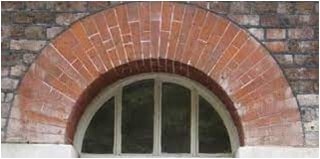
Fig 12: Fine Axed Brick Arches
Courtesy: medium.com
The Fine Axed arches are made by arranging bricks in a specific pattern. The bricks are cut into wedge-shaped properly any three commonly employed where the Fine work is required for building Fine axed brick arches. This sort of arch’s completed surface has a very attractive appearance.
c) Gauged Brick Arches:
With a wire saw, bricks are cut to the exact shape and size of the required voussoir in this sort of arch. The bricks are neatly dressed, and lime putty is used to unite them. Only soft bricks are utilized for gauged brick arches
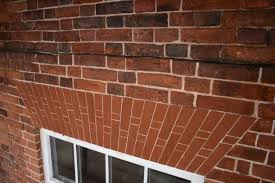
Fig 13: Gauge Brick Arches
Courtesy: terrenceleeconservation.co.uk
iii) Concrete Arches:
a) Monolithic Concrete Block Arches:
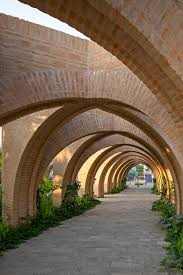
Fig 14: Monolithic Concrete Block Arches
Courtesy: worldarchitechture.org
Initially, monolithic concrete arches were used for longer spans. Cast-in-situ concrete, either plain or reinforced, makes monolithic concrete block arches. The thickness of the arches up to 3 m spans is roughly 15 cm. It is critical to curing the monolithic concrete block for 14 to 28 days.
b) Precast Concrete Block Arches:
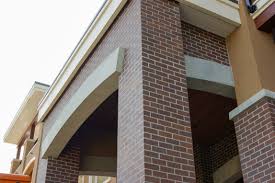
Fig 15: Precast Concrete Block Arches
Courtesy: sandersonconcrete.ca
The blocks are cast in molds to the exact shape and size of the voussoirs in precast concrete block arches. Special molds are made for keystones and skewbacks. Because of their precise shape and size, these will have a pleasing appearance. A 1:2:4 cement concrete mixes is employed.
3. Types of Arches According to Number of Centre:
a). One Centered Arch:
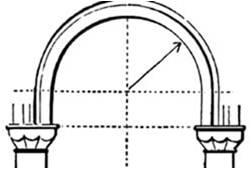
Fig 16: One Centered Arch
Courtesy: theconstructor.org
One-centered arches include segmental, semi-circular, flat, horseshoe, and stilted arches. In some situations, a perfectly round arch is given for circular windows, known as a bull’s eye arch, which falls into this category.
b) Two Centered Arches:
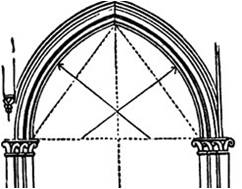
Fig 17: Two Centered Arches
Courtesy: civiconcepts.com
Arches with two centers are known as two-centered arches. Two-centered arches include pointed arches, gothic arches, and lancet arches. Semi-elliptical arches are included in this category.
c) Three Centered Arches:
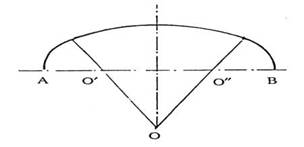
Fig 18: Three Centered Arches
Courtesy: theconstructor.org
There are three centers in these types of arches. The category of three centered arches includes elliptical and equilateral arches.
d) Four Centered Arches:
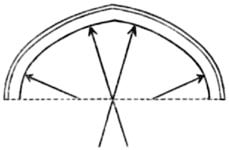
Fig 19: Four Centered Arches
Courtesy: medium.com
There are four centers in these types of arches. Venetian arches are classified as four-center arches since they have four centers. Tudor also falls into this category.
e) Five Centered Arches:
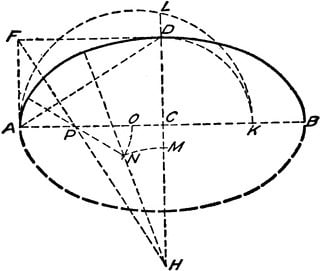
Fig 20: Five Centered Arches
Courtesy: medium.com
The five center arches have five centers, which allows for a good semi-elliptical shape.
Conclusion:
Arches and their types have their values, significance, and applications. Some are just utilized for architectural support and strength, while others add a unique touch and special appearances to your places.
References:
1. Types of Arches Construction based on Shape, Material, Workmanship. (2016, May 14). The Constructor; theconstructor.org. https://theconstructor.org/structures/types-of-arches-construction/11960/
2. Patel, M. (2019, March 1). What is Arch in Construction? GharPedia; gharpedia.com. https://gharpedia.com/blog/what-is-arch-in-construction/
3. Staff & Writers, H. E. (2018, July 16). 30 Types of Architectural Arches (with Illustrated Diagrams) – Home Stratosphere. Home Stratosphere; www.homestratosphere.com. https://www.homestratosphere.com/types-of-arches/
4. Types of Arches in Construction (13 Different Types). (2020, June 20). Constructionor.Com; constructionor.com. https://constructionor.com/types-of-arches/
5. 13 Types of Arches Construction, Shape, and Material. (2020, 0 3). Civil Knowledges; www.civilknowledges.com. https://www.civilknowledges.com/types-of-arches/
If you have a query, you can ask a question here.


